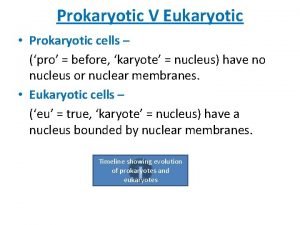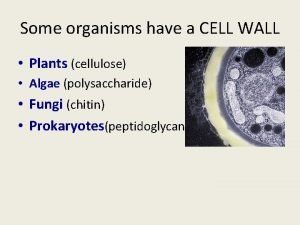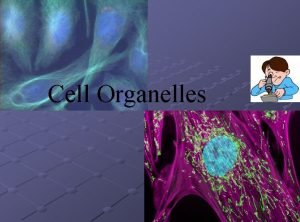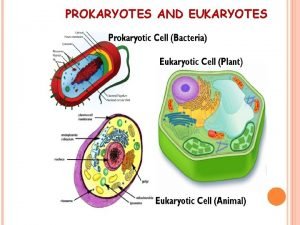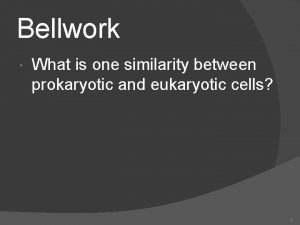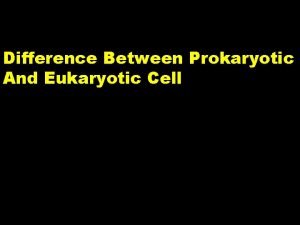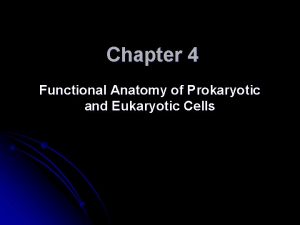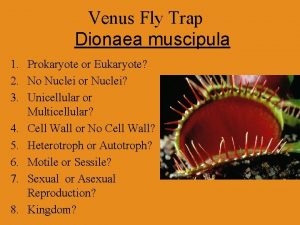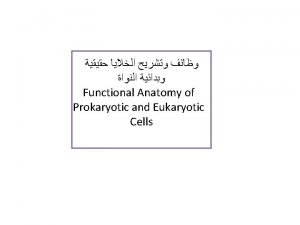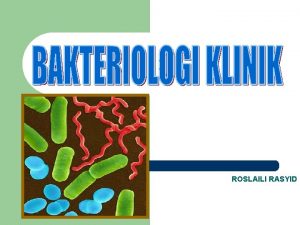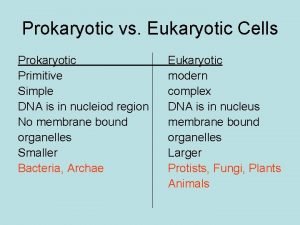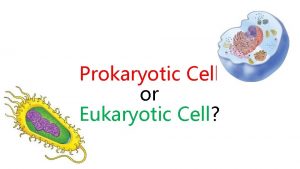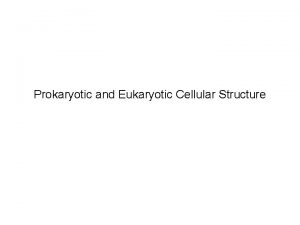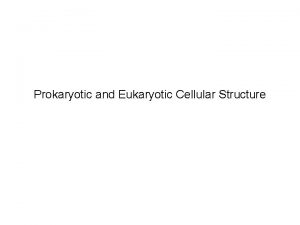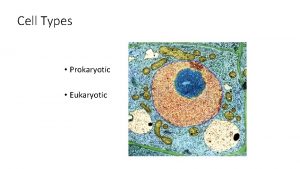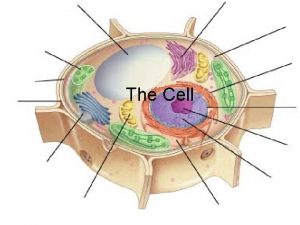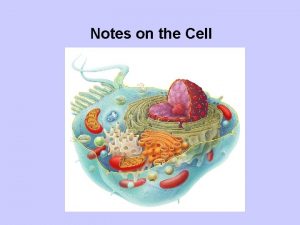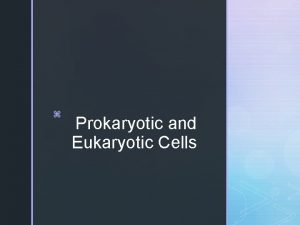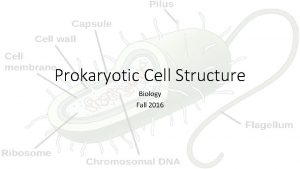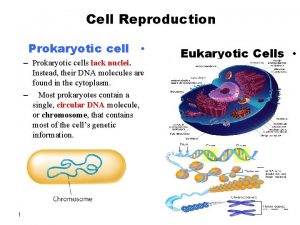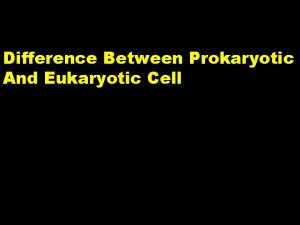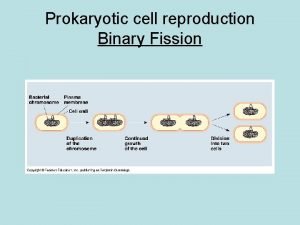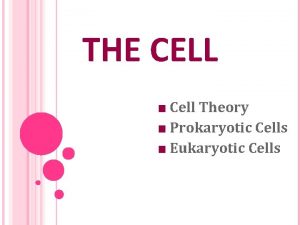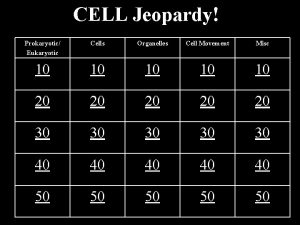Cell Growth Division Prokaryotic and Eukaryotic Cell Division

























- Slides: 25

Cell Growth & Division Prokaryotic and Eukaryotic Cell Division

What limits cell size? � 1. Amount of DNA : if the cell becomes too large it may not have enough DNA to control normal cell functions. � 2. Cell Transport : the larger the cell, the more difficult it becomes to regulate cell transport and maintain homeostasis. � 3. Surface Area to Volume Ratio : the volume of a cell increases faster than the surface area putting stress on the cell membrane and slowing down cell processes.

What must a cell do? � In order for the cell to survive when it gets too large it must: �DIVIDE or DIE

Prokaryotic Cell Division � Remember: : Prokaryotic cells are different from Eukaryotic cells because they do NOT have a nucleus. � Because there is no nucleus in prokaryotic cells the DNA floats freely in the cytoplasm in a circular structure called a plasmid.

Prokaryotic Cell Division Asexual Reproduction: reproduction that requires only one parent or source of DNA � this creates an identical copy of the parent Binary Fission: the type of asexual reproduction that creates new bacterial cells

Eukaryotic Cell Division � Remember: : DNA in eukaryotic cells is found in the nucleus. � DNA is organized into structures called chromosomes. � In order for a eukaryotic cell to divide into 2 identical new cells the nucleus must dissolve and the chromosomes must be copied.

Eukaryotic Cell Division � Chromosomes are made of DNA wrapped around a protein called a histone. � Before cell division, after the DNA has been copied, the two copies come together to form an X shape held together in the middle by a centromere. � Each copy is called a chromatid. � Together the two copies are called sister chromatids.

Eukaryotic Cell Division � All organisms have a specific number of chromosomes Example: Humans have 46 chromosomes and Bananas have 22 chromosomes. � Chromosomes are only visible during cell division. Usually they are uncoiled thin strands called chromatin.

Eukaryotic Cell Division Cell Cycle: the process by which a eukaryotic cell divides to form two new eukaryotic cells called “daughter cells” � Daughter cells are identical to the parent cell meaning it is a form of asexual reproduction.

Eukaryotic Cell Division Stages of the Cell Cycle: 1. Interphase: preparation for cell division 2. Mitosis: division of nuclear material (chromosomes) 3. Cytokinesis: division of material outside of the nucleus (cytoplasm and organelles)

Cell Cycle Interphase (longest stage of cell cycle) � G 1 – initial growth to normal size � S – synthesis of DNA (makes a copy) � G 2 – growth to 2 x the normal size

Cell Cycle M phase � Mitosis – nuclear division � Cytokinesis – cytoplasmic division

Phases of Mitosis 1. Prophase � Chromatin coils into visible chromosomes Nuclear membrane starts to disappear Spindle fibers start to form Centrioles move to opposite ends of the cell � �

Phases of Mitosis 2. Metaphase � Chromosomes line up at the center of the cell Spindle fibers attach to the centromeres �

Phases of Mitosis 3. Anaphase � Centromeres pull apart Sister chromatids are pulled to opposite ends of the cell �

Phases of Mitosis 4. Telophase Cell has 2 complete sets of chromosomes � Spindle fibers disappear � Nuclear membrane reappears � Chromosomes start to uncoil back into chromatin �

Cytokinesis �Cytokinesis marks the complete separation of the cytoplasm and cell barriers (cell membrane or cell wall) into new cells

Cell Division Video � During cell division chromosomes are easily visible with even simple light microscopes � Videos of cell division show the continuous motion and the precision of the mitosis process � Video of actual cell division using a microscope

Cytokinesis Animal Cells �Cleavage furrow forms at middle of cell �Cytoplasm underneath pinches in forming 2 new daughter cells

Cytokinesis Plant Cells �Vesicles form a cell plate at equator �Cell plate grows into the existing cell wall forming 2 new cells

Cell Cycle Control What limits cell division? �The cell cycle is controlled by proteins called cyclins. � Cyclins activate enzymes called cyclin dependent kinase that control different parts of the cell cycle

Cell Cycle Control � Cell growth is also affected by environmental changes. � Contact inhibition occurs when the cell senses that all of the space around it has been taken up so there is no more room to grow. � Cell division stops when there is no more room for new cells.

Cancer �Cancer is defined as uncontrolled cell growth. �Cancerous cells have cyclins that have been altered and no longer regulate cell cycle changes or no longer exhibit contact inhibition.

Cancer

Cancer � Environmental factors like cigarette smoke, pollution, and radiation exposure all known to damage the genes that control the cell cycle and increase the risk of cancer. � Daily exercise, healthy diet and staying away from known carcinogens can help to reduce the risk of cancer.
 Linear chromosomes in eukaryotes
Linear chromosomes in eukaryotes Prokaryotic cell and eukaryotic cell
Prokaryotic cell and eukaryotic cell Site:slidetodoc.com
Site:slidetodoc.com Eukaryotic cells vs prokaryotic cells
Eukaryotic cells vs prokaryotic cells Karyote
Karyote Dialysis membrane
Dialysis membrane Are cell walls prokaryotic or eukaryotic
Are cell walls prokaryotic or eukaryotic Are cell walls prokaryotic or eukaryotic
Are cell walls prokaryotic or eukaryotic Cytoskeleton prokaryotic or eukaryotic
Cytoskeleton prokaryotic or eukaryotic Prokaryotic cell wall
Prokaryotic cell wall Prokaryotic promoter vs eukaryotic promoter
Prokaryotic promoter vs eukaryotic promoter Cloroplasto
Cloroplasto 3 parts of the cell theory
3 parts of the cell theory Prokaryotes and eukaryotes
Prokaryotes and eukaryotes What is eukaryotic and prokaryotic
What is eukaryotic and prokaryotic Similarity between prokaryotic and eukaryotic cells
Similarity between prokaryotic and eukaryotic cells Lable
Lable Prokaryotic and eukaryotic cells chart
Prokaryotic and eukaryotic cells chart Similarities between prokaryotic and eukaryotic cells
Similarities between prokaryotic and eukaryotic cells Differences between prokaryotic and eukaryotic cells
Differences between prokaryotic and eukaryotic cells Anatomy of prokaryotes and eukaryotes
Anatomy of prokaryotes and eukaryotes Is a venus fly trap prokaryotic or eukaryotic
Is a venus fly trap prokaryotic or eukaryotic Chromosomes prokaryotic or eukaryotic
Chromosomes prokaryotic or eukaryotic Modern classification of living organisms
Modern classification of living organisms Lofotrich
Lofotrich Parasitism
Parasitism




